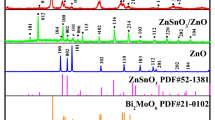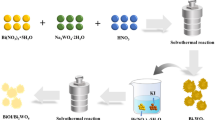Abstract
The synergism between different surface facets of semiconductor with optimal ratios can contribute to obtain enhanced photocatalytic degradation performance. Herein, a bismuth-based material Bi4Ti3O12 exposed with {001} top facets and {010}/{100} lateral facets was prepared by the molten-salt method. More importantly, the ratio of different exposed facets could be controlled by adjusting the synthesis temperature of molten-salt synthesis process. The as-prepared Bi4Ti3O12 exposed with the optimal ratio of {001} top facets to {010}/{100} lateral facets exhibited the enhanced degradation activity of tetracycline hydrochloride (TC-HCl) under irradiation. The rate constant of optimal sample reached 0.904% min−1, over 3.3 times as compared with that of the counterpart with higher proportion of {001} facets. Besides, active species trapping experiments, photoelectrochemical measurements and selective photodeposition tests were used to illuminate the photocatalytic degradation mechanism. According to that, the enhanced degradation activity could be ascribed to crystal facet synergism which can promote photoinduced carrier separation. This work can give insights into designing and constructing other two-dimensional (2D) bismuth-based materials with the aim of enhancing photocatalytic degradation performance.











Similar content being viewed by others
References
Trovó AG, Pupo Nogueira RF, Agüera A, Fernandez-Alba AR, Malato S (2011) Degradation of the antibiotic amoxicillin by photo-Fenton process–chemical and toxicological assessment. Water Res 45:1394–1402
Yu X, Gao X, Lu Z, Liu X, Huo P, Liu X, Wu D, Yan Y (2013) Preparation and photodegradation properties of transition metal ion-poly-o-phenylenediamine/TiO2/fly-ash cenospheres by ion imprinting technology. RSC Adv 3:14807–14813
Xue X, Zang W, Deng P, Wang Q, Xing L, Zhang Y, Wang ZL (2015) Piezo-potential enhanced photocatalytic degradation of organic dye using ZnO nanowires. Nano Energy 13:414–422
Ye F, Li H, Yu H, Chen S, Quan X (2018) Constructing BiVO4-Au@CdS photocatalyst with energic charge-carrier-separation capacity derived from facet induction and Z-scheme bridge for degradation of organic pollutants. Appl Catal B: Environ 227:258–265
Shi W, Guo F, Yuan S (2017) In situ synthesis of Z-scheme Ag3PO4/CuBi2O4 photocatalysts and enhanced photocatalytic performance for the degradation of tetracycline under visible light irradiation. Appl Catal B: Environ 209:720–728
Xie Z, Feng Y, Wang F, Chen D, Zhang Q, Zeng Y, Lv W, Liu G (2018) Construction of carbon dots modified MoO3/g-C3N4 Z-scheme photocatalyst with enhanced visible-light photocatalytic activity for the degradation of tetracycline. Appl Catal B: Environ 229:96–104
Bai S, Wang L, Li Z, Xiong Y (2017) Facet-engineered surface and interface design of photocatalytic materials. Adv Sci 4:1600216
Li R, Zhang F, Wang D, Yang J, Li M, Zhu J, Zhou X, Han H, Li C (2013) Spatial separation of photogenerated electrons and holes among 010 and 110 crystal facets of BiVO4. Nat Commun 4:1432
Zhao K, Zhang L, Wang J, Li Q, He W, Yin JJ (2013) Surface structure-dependent molecular oxygen activation of BiOCl single-crystalline nanosheets. J Am Chem Soc 135:15750–15753
Li J, Yu Y, Zhang L (2014) Bismuth oxyhalide nanomaterials: layered structures meet photocatalysis. Nanoscale 6:8473–8488
Li J, Zhao K, Yu Y, Zhang L (2015) Facet-level mechanistic insights into general homogeneous carbon doping for enhanced solar-to-hydrogen conversion. Adv Funct Mater 25:2189–2201
Jiang J, Zhao K, Xiao X, Zhang L (2012) Synthesis and facet-dependent photoreactivity of BiOCl single-crystalline nanosheets. J Am Chem Soc 134:4473–4476
Liu W, Shang Y, Zhu A, Tan P, Liu Y, Qiao L, Chu D, Xiong X, Pan J (2017) Enhanced performance of doped BiOCl nanoplates for photocatalysis: understanding from doping insight into improved spatial carrier separation. J Mater Chem A 5:12542–12549
Ding S, Xiong X, Liu X, Shi Y, Jiang Q, Hu J (2017) Synthesis and characterization of single-crystalline Bi2O2SiO3 nanosheets with exposed 001 facets. Catal Sci Technol 7:3791–3801
Li J, Zhao K, Yu Y, Zhang L (2015) Facet-level mechanistic insights into general homogeneous carbon doping for enhanced solar-to-hydrogen conversion. Adv Funct Mater 25:2189–2201
Ye L, Jin X, Ji X, Liu C, Su Y, Xie H, Liu C (2016) Facet-dependent photocatalytic reduction of CO2 on BiOI nanosheets. Chem Eng J 291:39–46
Li J, Cai L, Shang J, Yu Y, Zhang L (2016) Giant enhancement of internal electric field boosting bulk charge separation for photocatalysis. Adv Mater 28:4059–4064
Wang B, Shen S, Guo L (2015) SrTiO3 single crystals enclosed with high-indexed 023 facets and 001 facets for photocatalytic hydrogen and oxygen evolution. Appl Catal B: Environ 166–167:320–326
Zhong D, Liu W, Tan P, Zhu A, Liu Y, Xiong X, Pan J (2018) Insights into the synergy effect of anisotropic 001 and 230 facets of BaTiO3 nanocubes sensitized with CdSe quantum dots for photocatalytic water reduction. Appl Catal B: Environ 227:1–12
Shi H, Tan H, Zhu W-B, Sun Z, Ma Y, Wang E (2015) Electrospun Cr-doped Bi4Ti3O12/Bi2Ti2O7 heterostructure fibers with enhanced visible-light photocatalytic properties. J Mater Chem A 3:6586–6591
Yao WF, Xu XH, Wang H, Zhou JT, Yang XN, Zhang Y, Shang SX, Huang BB (2004) Photocatalytic property of perovskite bismuth titanate. Appl Catal B: Environ 52:109–116
Azodi M, Harnagea C, Buscaglia V, Buscaglia MT, Nanni P, Rosei F, Pignolet A (2012) Ferroelectric switching in Bi4Ti3O12 nanorods. IEEE Trans Ultrason Eng 59:1903–1911
Benedek NA, Rondinelli JM, Djani H, Ghosez P, Lightfoot P (2015) Understanding ferroelectricity in layered perovskites: new ideas and insights from theory and experiments. Dalton Trans 44:10543–10558
He H, Yin J, Li Y, Zhang Y, Qiu H, Xu J, Xu T, Wang C (2014) Size controllable synthesis of single-crystal ferroelectric Bi4Ti3O12 nanosheet dominated with 001 facets toward enhanced visible-light-driven photocatalytic activities. Appl Catal B: Environ 156–157:35–43
Liu Y, Zhu G, Peng J, Gao J, Wang C, Liu P (2016) One-step molten-salt method fabricated Bi2Ti2O7/Bi4Ti3O12 composites with enhanced photocatalytic activity. J Mater Sci: Mater Electron 28:2172–2182
Liu W, Dai Z, Liu Y, Zhu A, Zhong D, Wang J, Pan J (2018) Intimate contacted two-dimensional/zero-dimensional composite of bismuth titanate nanosheets supported ultrafine bismuth oxychloride nanoparticles for enhanced antibiotic residue degradation. J Colloid Interface Sci 529:23–33
Yin X, Li X, Liu H, Gu W, Zou W, Zhu L, Fu Z, Lu Y (2018) Realizing selective water splitting hydrogen/oxygen evolution on ferroelectric Bi3TiNbO9 nanosheets. Nano Energy 49:489–497
Huang M, Yan Y, Feng W, Weng S, Zheng Z, Fu X, Liu P (2014) Controllable tuning various ratios of ZnO polar facets by crystal seed-assisted growth and their photocatalytic activity. Cryst Growth Des 14:2179–2186
Qian K, Xia L, Jiang Z, Wei W, Chen L, Xie J (2017) In situ chemical transformation synthesis of Bi4Ti3O12/I-BiOCl 2D/2D heterojunction systems for water pollution treatment and hydrogen production. Catal Sci Technol 7:3863–3875
Weng B, Xu F, Xu J (2014) Synthesis of hierarchical Bi2O3/Bi4Ti3O12 p-n junction nanoribbons on carbon fibers from (001) facet dominated TiO2 nanosheets. RSC Adv 4:56682–56689
Qiao L, Zhu A, Liu W, Chu D, Pan J (2018) Novel two-dimensional Bi4V2O11 nanosheets: controllable synthesis, characterization and insight into the band structure. CrystEngComm 20:1116–1122
Shang Y, Chen X, Liu W, Tan P, Chen H, Wu L, Ma C, Xiong X, Pan J (2017) Photocorrosion inhibition and high-efficiency photoactivity of porous g-C3N4/Ag2CrO4 composites by simple microemulsion-assisted co-precipitation method. Appl Catal B: Environ 204:78–88
Tan P, Chen X, Wu L, Shang YY, Liu W, Pan J, Xiong X (2017) Hierarchical flower-like SnSe2 supported Ag3PO4 nanoparticles: towards visible light driven photocatalyst with enhanced performance. Appl Catal B: Environ 202:326–334
Liu W, Qiao L, Zhu A, Liu Y, Pan J (2017) Constructing 2D BiOCl/C3N4 layered composite with large contact surface for visible-light-driven photocatalytic degradation. Appl Surf Sci 426:897–905
Liu Y, Zhu G, Gao J, Hojamberdiev M, Lu H, Zhu R, Wei X, Liu P (2016) A novel CeO2/Bi4Ti3O12 composite heterojunction structure with an enhanced photocatalytic activity for bisphenol A. J Alloys Compd 688:487–496
Bian Y, Ma Y, Shang Y, Tan P, Pan J (2018) Self-integrated β-Bi2O3/Bi2O2.33@Bi2O2CO3 ternary composites: formation mechanism and visible light photocatalytic activity. Appl Surf Sci 430:613–624
Zhou Y, Tian Z, Zhao Z, Liu Q, Kou J, Chen X, Gao J, Yan S, Zou Z (2011) High-yield synthesis of ultrathin and uniform Bi2WO6 square nanoplates benefitting from photocatalytic reduction of CO2 into renewable hydrocarbon fuel under visible light. ACS Appl Mater Interfaces 3:3594–3601
Cao T, Li Y, Wang C, Zhang Z, Zhang M, Shao C, Liu Y (2011) Bi4Ti3O12 nanosheets/TiO2 submicron fibers heterostructures: in situ fabrication and high visible light photocatalytic activity. J Mater Chem 21:6922
Chen F, Huang H, Ye L, Zhang T, Zhang Y, Han X, Ma T (2018) Thickness-dependent facet junction control of layered BiOIO3 single crystals for highly efficient CO2 photoreduction. Adv Funct Mater 28:1804284
Acknowledgements
We greatly acknowledge the financial support of the National Natural Science Foundation of China (Grant No. 11674398).
Author information
Authors and Affiliations
Corresponding authors
Ethics declarations
Conflict of interest
There are no conflicts of interest to declare.
Additional information
Publisher's Note
Springer Nature remains neutral with regard to jurisdictional claims in published maps and institutional affiliations.
Rights and permissions
About this article
Cite this article
Wang, J., Liu, W., Zhong, D. et al. Fabrication of bismuth titanate nanosheets with tunable crystal facets for photocatalytic degradation of antibiotic. J Mater Sci 54, 13740–13752 (2019). https://doi.org/10.1007/s10853-019-03882-1
Received:
Accepted:
Published:
Issue Date:
DOI: https://doi.org/10.1007/s10853-019-03882-1




